The American Society of Heating, Refrigeration, and Air Conditioning Engineers (ASHRAE) has recently published Standard 241, Control of Infectious Aerosols. The new standard is developed with an aim of limiting the spread of airborne pathogens in HVAC systems, particularly in healthcare facilities and other indoor environments where the risk of transmission is high. In this article, we will delve into the details of ASHRAE Standard 241 and its impact on the plumbing and HVAC industry.
The Need for ASHRAE Standard 241
The COVID-19 pandemic has highlighted the need for better indoor air quality control, as an increasing number of studies indicate that the novel coronavirus can be transmitted through the air. While social distancing, wearing masks, and hand hygiene have been the primary measures to prevent the spread of COVID-19, the role of HVAC systems in reducing airborne transmission has been largely overlooked. Poorly designed or maintained HVAC systems can recirculate contaminated air, which can result in the rapid spread of airborne illnesses, especially in crowded buildings.

ASHRAE Standard 241 aims at providing guidance on how to design, construct, install, and operate HVAC systems to minimize the risks of airborne transmission of infectious pathogens. The standard establishes minimum requirements and best practices for the control of infectious aerosols, including requirements for system design, operation, maintenance, and testing.
Key Provisions of ASHRAE Standard 241
ASHRAE Standard 241 includes several key provisions that aim at reducing the risk of airborne transmission of infectious pathogens, including:
1. Ventilation Rate – The standard provides guidance on the minimum ventilation rate required to dilute any airborne pathogen concentrations in indoor environments.
2. Filtration – The standard sets minimum requirements for filter efficiency and recommends the use of high-efficiency filters for controlling infectious aerosols.
3. UVGI – The standard recommends the use of ultraviolet germicidal irradiation (UVGI) systems in the HVAC system to control the spread of infectious aerosols.

4. Humidity Control – The standard recommends the use of humidification or dehumidification systems in the HVAC system to control RH levels and limit the growth of airborne pathogens.
5. System Maintenance – The standard provides specific recommendations for the maintenance and cleaning of HVAC systems to minimize the risk of airborne transmission of infectious pathogens.
ASHRAE Standard 241 and the Plumbing Industry
While ASHRAE Standard 241 is primarily aimed at HVAC systems, it has implications for the plumbing industry, as well. Plumbing systems can act as conduits for the spread of airborne pathogens, particularly in healthcare facilities and other indoor environments with high-risk populations. To mitigate this risk, plumbing systems must be designed, installed, and maintained in accordance with best practices to prevent the accumulation and spread of infectious aerosols.
Some of the key considerations for the plumbing industry to ensure compliance with ASHRAE Standard 241 include:
1. Proper Drainage – Plumbing systems must be designed to prevent the accumulation of standing water, which can be a breeding ground for microorganisms.
2. Water Treatment – Water used in plumbing systems must be treated to prevent the growth of microorganisms and pathogens.
3. System Maintenance – Plumbing systems must be regularly inspected and maintained to prevent the buildup of biofilms and other contaminants.
4. Cross-Connection Control – Measures must be taken to prevent the backflow of contaminated water into the potable water supply.
Conclusion
ASHRAE Standard 241 is a significant step forward in promoting better indoor air quality and reducing the risk of airborne transmission of infectious pathogens. The standard provides a framework for the design, installation, operation, and maintenance of HVAC systems to minimize the risk of the spread of infectious aerosols. Compliance with the standard can help to protect the health and safety of building occupants, particularly in healthcare facilities and other high-risk environments.
The plumbing industry also has a role to play in reducing the risk of airborne transmission of infectious pathogens. Plumbing systems must be designed and maintained in accordance with best practices to prevent the accumulation and spread of infectious aerosols. By adhering to these standards, the plumbing industry can play a critical role in helping to protect public health and safety. For more information on designing and maintaining ASHRAE-compliant plumbing systems, visit our website at aceplumbingrepair.com or give us a call at (844) 711-1590.






